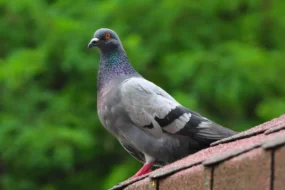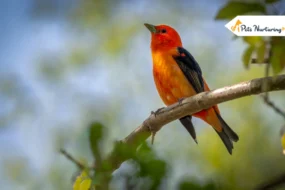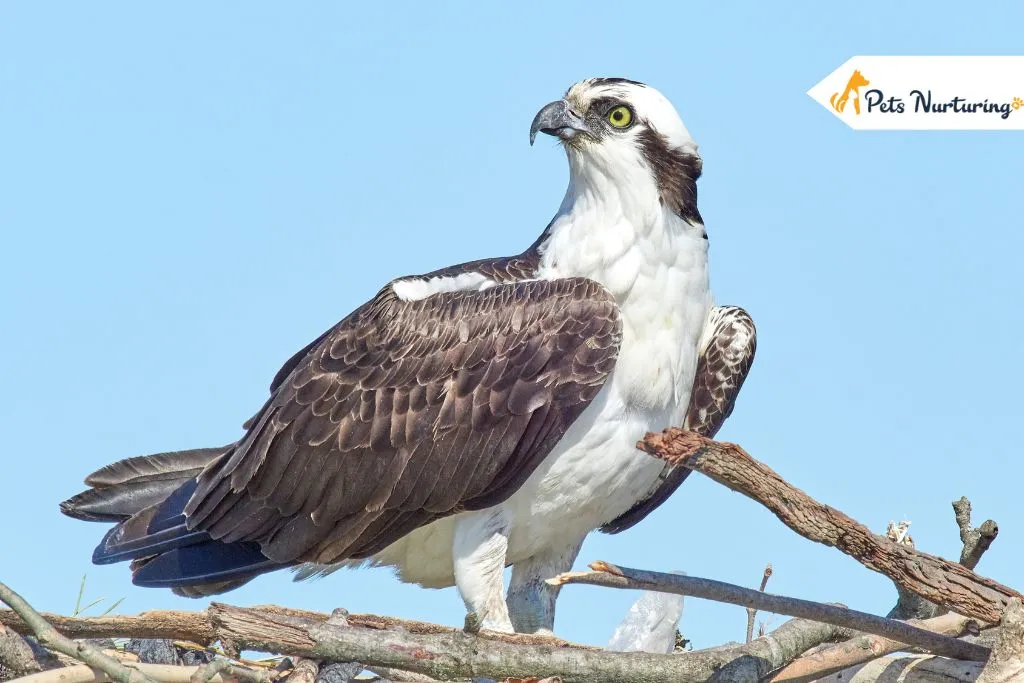
When it comes to birds, people often talk about domestic ones like parrots, ducks, pigeons and canaries. But today, we are going to discuss a totally different category of bird – the Osprey.
Osprey falls into the category of birds of prey because it is known for hunting fishes. Because of this reason, it is also known as the “fish hawk. You can find this unique raptor along coastlines, rivers and lakes almost everywhere around the world except the Antarctica continent.
These birds are truly majestic with their beautiful wings and black, brown and white coloration. Apart from their fishing skills, the Ospreys are also known for long migrations.The birds that live in warm regions stay there throughout the year, but the ones in cold regions migrate as the season changes.
Want to know more about this raptor? Keep reading.
In this article, we are going to discuss everything about Ospreys, from their origin and habitat to diet and nesting.
So, let’s get started!
Overview Of Osprey Bird
Osprey Bird Overview
Name: Osprey Bird
Other Names: Sea Hawk, Fish Hawk and River Hawk
Length: Osprey bird size is approximately 21 to 24 inches
Wingspan: 59 to 71 inches
Weight: 3.1 to 4.4 pounds
Feather Color: Dark brown on top and white on the head and underparts
Leg Color: Gray or light blue-gray
Beak: Hooked and sharp beak with dark color
Lifespan: 7-10 years in wild and up to 25 years in captivity
History of Osprey Birds

The Osprey is a bird with a long history, commonly found near bodies of water worldwide. These birds have been around for ages, with their ancestors dating back millions of years.
The scientific name of the Osprey is Pandion haliaetus. “Pandion” is connected to a Greek myth about an Athenian king and his children. “Haliaetus” comes from a Greek meaning “fishing eagle.”
Now, as for the name “osprey” in English, its origin is a bit uncertain. It’s thought to have come from Medieval Latin, “avis prede,” which means “bird of prey.” It might have evolved through the Norman word “ospriet.”
The history of Osprey birds goes way back, with fossil evidence showing their existence 10 to 15 million years ago. They’ve made their mark in history in several ways:
- From around 1200 to 165 BC, Ospreys were mentioned in the Old Testament as birds not to be eaten.
- In 1609, William Shakespeare mentioned Ospreys in his play “Coriolanus,” hinting that he might have seen these birds himself.
- Between the 1700s and 1800s, humans persecuted Ospreys, collecting them for various purposes, taking their eggs, and even shooting them for display.
- In 1847, Ospreys began to disappear in many regions.
However, with conservation initiatives and growing public awareness, Osprey birds are out of danger. You can easily spot them flying above water bodies in search of fish.
Where Osprey Birds Live
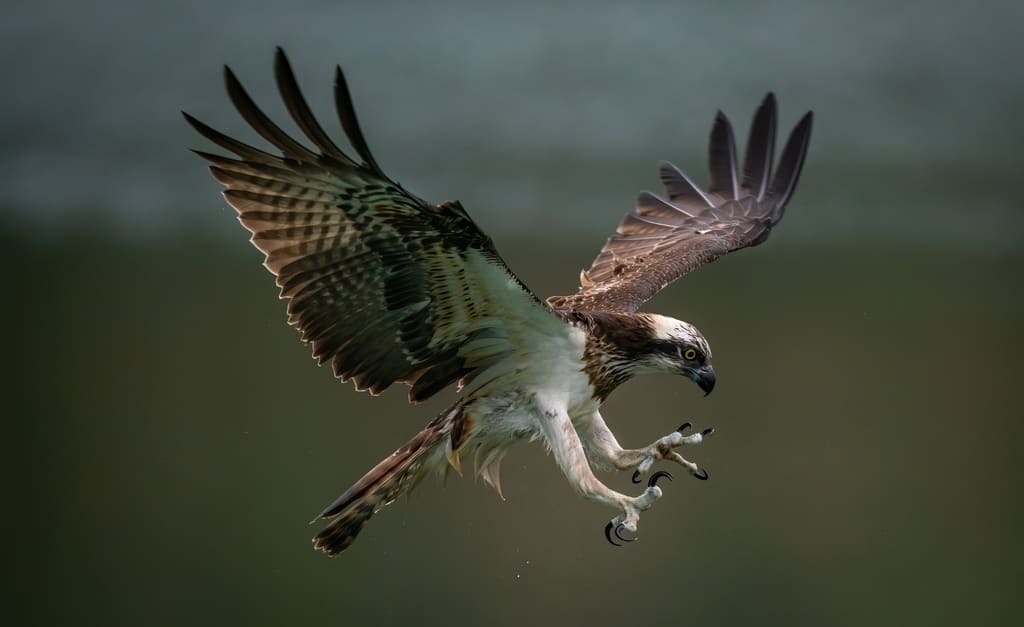
The Osprey is a type of bird that can be found in many places around the world. It’s not as common as the peregrine falcon, but it’s still one of the birds you can see in many places. You won’t find it in Antarctica, but you can spot it in places with mild and warm weather on all continents.
Ospreys like to hang out near all kinds of water, like oceans, rivers, lakes, and marshes. They don’t have a specific location, so you might even see them close to mangroves, lagoons, and reefs.
The Osprey bird inhabits regions of North America, including Alaska and Florida, and migrates to even warmer destinations like Argentina for the winter.
During the summer months, one can observe the Osprey in European countries like Ireland and Scandinavia, but it heads to North Africa for the winter season.
In Australia, it primarily resides along the coastal areas but, during the breeding season, some individuals venture to eastern Victoria and Tasmania.
In the Pacific Islands, you can find it in places like the Bismarck Islands, Solomon Islands, and New Caledonia. They’ve even found the remains of ospreys in Tonga, but it seems they disappeared when people arrived. You must know this real phoenix bird in detail.
In parts of South Asia and Southeast Asia, it’s not very common, but you might see it during the winter. It travels through countries like Myanmar, Indochina, China, Indonesia, Malaysia, and the Philippines.
What Osprey Birds Do
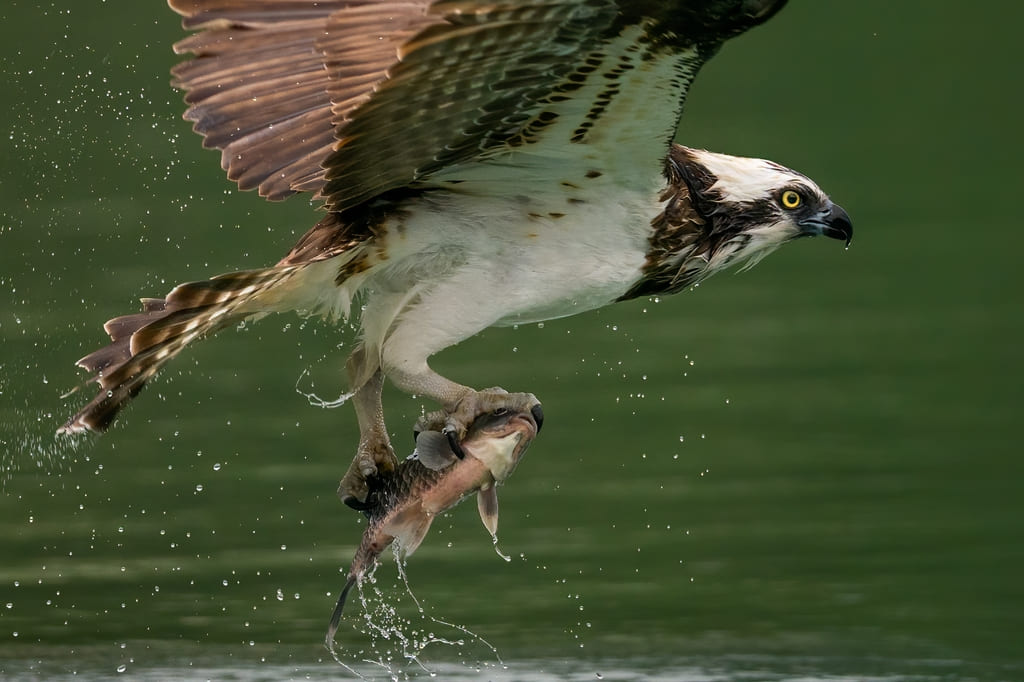
Ospreys have only three major things to do – hunt fish, mate, reproduce and migrate.
Hunting Fish
Ospreys are skilled fish hunters that are frequently spotted around bodies of water. They can effectively grasp fish thanks to their lengthy legs, huge feet with distinctive barbs, sharp talons, and peculiar toes.
When diving into the water, their oil-coated wings keep them dry. In order to prevent getting water in their noses while diving, they can also seal their nostrils.
The bird Osprey can lift off even with large prey and swoop down to grab fish thanks to their long, flexible wings and slim bodies.
Mating and Reproduction
Ospreys are knowledgeable family-rearing and expert hunters. They build their nests near water bodies using sticks, driftwood, and more.
They usually become parents at around three to four years old, though it can be later if nesting spots are scarce. Sometimes, people set up posts to help them find suitable nesting sites.
Osprey pairs often mate for life, performing courtship dances and exchanging fish gifts. The female lays two to four eggs, incubating them for about 35 to 43 days. Younglings hatch and stay in the nest for 8 to 10 weeks before learning to fly.
Migration
Osprey birds are avid travelers. European ones fly to Africa for winter, while American and Canadian Ospreys head to South America. Some Florida Osprey birds also join the journey south.
Female Ospreys start migrating to Africa earlier than males. During migration, they can travel up to 431 kilometers in a day.
In the Mediterranean, Ospreys have different migration patterns, with some staying year-round and others making shorter trips.
One adventurous Osprey even traveled from Norway to western India, showcasing their impressive wingspan. Whether near or far, Ospreys are skilled wanderers.
Osprey Bird Feeding Behaviors
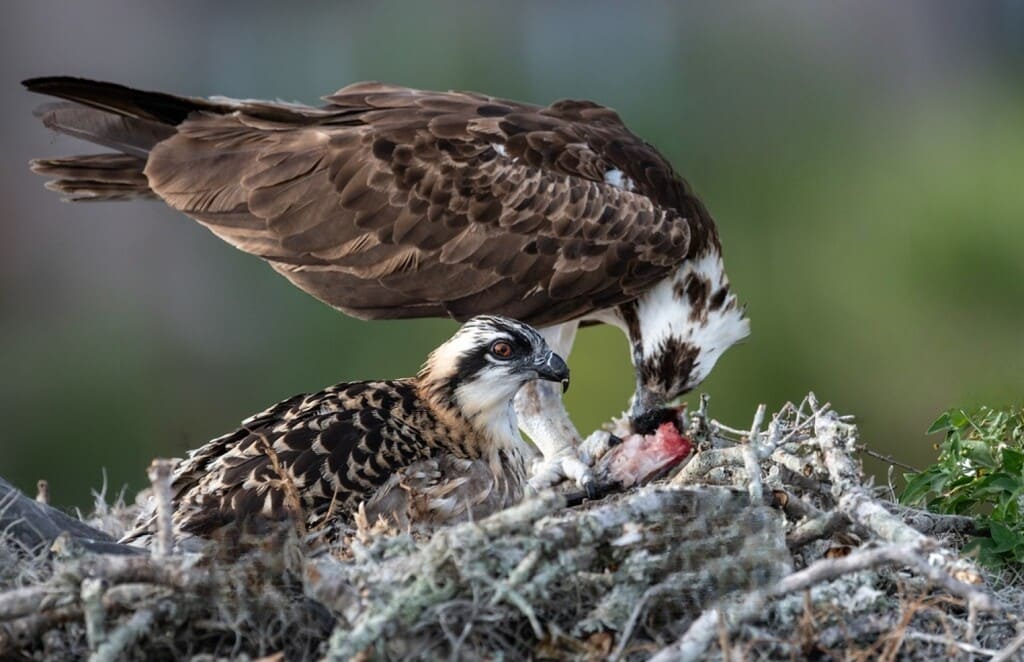
Most Ospreys are pretty flexible when it comes to their meals. They like to eat whatever fish is easy to find and just the right size. They’re not really built for deep dives, so they usually catch fish near the surface of the water.
When they’re on the hunt, Ospreys typically search for their dinner while flying in the sky. It takes more energy to do it this way, but it lets them cover a larger area. During the winter, they’re more likely to sit on a perch and hunt because they only need to feed themselves.
While they’re out hunting, Ospreys fly slowly above the water and sometimes pause in the air to look really carefully. When they spot a fish, they fold their wings and dive straight down. They utilize their tail and wings to precisely position themselves as they descend. Then, with their talons and legs spread wide, they plunge into the sea.
Once they’ve dived, they take a brief rest in the water to ensure they have a firm hold on their prey before taking flight with it. They place one foot in front of the other and position the fish so that its head is pointing forward when they are in the air with a fish.
With two talons on each side to assist them in retaining the fish and prevent it from slipping away, they have a unique flexible toe. When it’s time to dine, they savor their food with their sharply hooked black beak.
The Osprey’s unique characteristics enable it to lead a diet high in fish:
- Their outer toes can rotate backward.
- Tiny, sharp spikes grow on the undersides of their toes.
- When they dive, they can shut their nostrils to keep water out.
- To improve their grip on the catch, the scales on their talons point backward like barbs.
- To prevent them from becoming wet, their feathers are greasy and thick.
Osprey Bird Eggs
Typically, the female Osprey lays two to four white eggs with dark brown and reddish-brown markings. While both sexes alternate in keeping the eggs warm, the mother does so more frequently.
The mother stays with the offspring for a long period after they hatch, keeping them warm and dry. The mother feeds the young ones, and the father assists by bringing fish.
Between 51 and 54 days is when the baby ospreys begin to learn how to fly. After they are able to fly, they stay with their parents for several more months so they can become independent in the wild.
What Osprey Birds Eat
Fish comprises nearly all of an osprey’s diet. They often target live fish that are 25 to 35 cm long and weigh between 150 and 300 grams. They have also been observed scooping up enormous 2.8 kg northern pike in certain locations.
Fish that are already dead or near death are rarely eaten by osprey birds. For a delicious supper, they would rather catch their own fresh fish. Usually, they take their prey with them and carry it a short distance before enjoying it on a nearby perch.
Occasionally, they may vary things up and eat something other than fish. Rats, rabbits, birds, snakes, turtles, frogs, and even some seafood like crabs and shrimp have all been observed as their favorite foods. Ospreys have been observed occasionally gorging on dead animals, such as opossums and deer; however, this is uncommon.
Osprey Bird Nesting
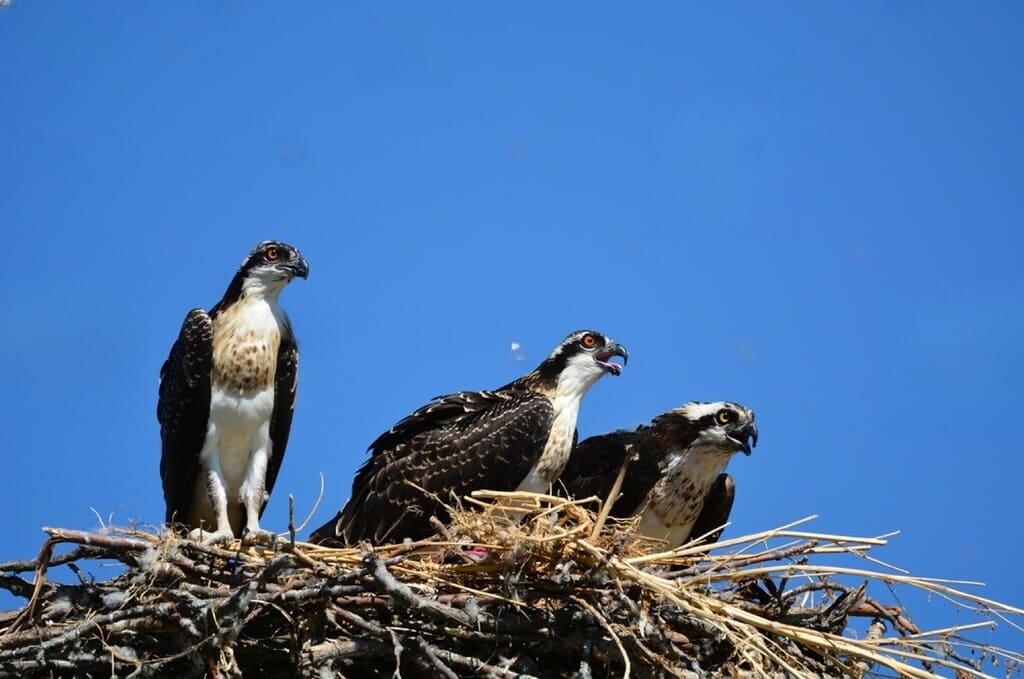
When it comes to choosing their nest sites, ospreys are pretty inventive. Even though they typically nest in tall locations like trees or power poles, observers have also seen them nesting in unusual areas, including rocky cliffs, offshore rocks, and even the ground.
When it comes time to construct their nests, osprey birds go all out. They employ a variety of materials to create some of the largest nests you will ever see. To build a stable foundation, they begin with big sticks and then add seaweed, bark, leaves, grass, and occasionally even strange objects like fishing nets or plastic bottles.
The interesting thing is that they just add new items to the same nest each year. So, some of their nests get super big over time. These nests can be as wide as 2 meters and weigh about 135 kg.
FAQs
Seeing an osprey is not unusual, especially in the summertime around the seaside.
The osprey bird is unique in that it is an excellent fish eater that frequently catches meals by plunging into the water.
They live around water bodies in every continent except Antarctica.
The typical lifespan of Osprey birds is 7 to 10 years, but they can live even longer in captivity.
Conclusion
That’s all about Osprey birds. These raptors were once considered endangered but are now safe and soaring through the skies. These birds have excellent hunting skills, particularly when it comes to capturing fish. To ensure a consistent supply of fish, they migrate during the winter months and prefer warm climates. One interesting fact about these birds is that they pair for life and are monogamous. We hope our guide about osprey birds proves to be helpful to you.
Explore Further:-








